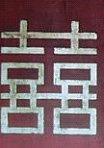
This article explores the Double happiness symbol, its design, origin and use. Unlike other symbols famed for their hazy details on origin, this symbol is said to have originated from simple love story. The resulting wedding celebration symbol birthed the double happiness symbol and halts any further demands to dig up chunks of history to determine origins.
Origin
 The origin of this symbol is both laced with romantic overtures, as well as accurate and verifiable historical context. It is speculated that in the Tang Dynasty, a young male Chinese Student set about travelling to the Dynasty’s capital in order to sit an examination. Expectations with the outcome of the examination were such that the top most students would receive the honor of serving at the court. Whilst en route, he fell ill just while in a village called Liukeng, located on the slopes of Donghua Mountain. While there, he received medical care from a herbalist who worked alongside his daughter. The student fell in love with the daughter of the herbalist and decided to propose to her. In response, the daughter of the herbalist recited some incomplete verse:
The origin of this symbol is both laced with romantic overtures, as well as accurate and verifiable historical context. It is speculated that in the Tang Dynasty, a young male Chinese Student set about travelling to the Dynasty’s capital in order to sit an examination. Expectations with the outcome of the examination were such that the top most students would receive the honor of serving at the court. Whilst en route, he fell ill just while in a village called Liukeng, located on the slopes of Donghua Mountain. While there, he received medical care from a herbalist who worked alongside his daughter. The student fell in love with the daughter of the herbalist and decided to propose to her. In response, the daughter of the herbalist recited some incomplete verse:
“Green trees against the sky in the spring rain while the sky set off the spring trees in the obscuration”
Her response to the student, though startling, was to the effect that he’d have to find the rest of the wording. The student implored on the girl for patience as he’d have to sit the examinations before responding. The outcome of the examinations showed the young man had performed exceptionally well and was well liked by the dynasty’s emperor. The Emperor, as a last stage of the examination process, recited some part of a verse and required that whoever would complete it would be the overall winner and would serve in the Emperor’ court. The Kings words were:
“Red flowers dot the land in the breeze’s chase while the land colored up in red after the kiss.”
The Young man immediately found some flow in the Emperor’s words if they were to be preceded by the girl’s words. He was declared the winner and would serve as a minister. When he met the girl, the young man recited the King’s words to her. Elatedly, they got married in a hurriedly convened wedding ceremony.
It is speculated that at the ceremony, the young couple had taken the Chinese character for happiness and doubled it up against some red background on the wall. It was considered a double celebration. The double ‘HAPPY’ character, therefore, became the origin of the symbol, ‘Double happiness’ today.
Description & Usage
This is a symbol of marriage among the Chinese people. As a ligature, the symbol is a lettering of two characters of the Chinese language: the 喜喜. When combined, the characters give a combined sense of joy and were therefore commonly used in celebrations such as weddings and lunar New Year festivities.
It is said to be placed in houses, years after wedding celebrations, to curtail any probable conflicts. The symbol heralds good luck, fortune and happiness in marriages and cultivates feelings of commitment, love and mutual respect.
In the modern day, the Shuang shi or shuāngxǐ (in pinyin) symbol is extensively used in works of art, decorations and on many manufactured products such as jewelry. The characters (for double happiness) are written in plain red or, occasionally, black. These decorations are common especially with gift products targeting both the bride and groom during weddings. Wedding invitation cards often bear this symbol as well. The symbol would also grace the thematic backgrounds of wedding ceremonies as a sign of good will and luck for marriages.
Conclusion
In conclusion, the double happiness symbol is more relevant, thematically speaking, in romantic and love contexts more than religious application. The symbol’s spiritual relevance comes into play in lieu of the idea that the symbol represented some celestial backing for marriages once the sign was used. Whether it is simple belief that works or simple acts of spiritual naivety, the bottom line remains that the symbol is widely used. It would therefore be an act of disconcertion to attempt to demand empirical support for symbol’s effectiveness. Needless.

